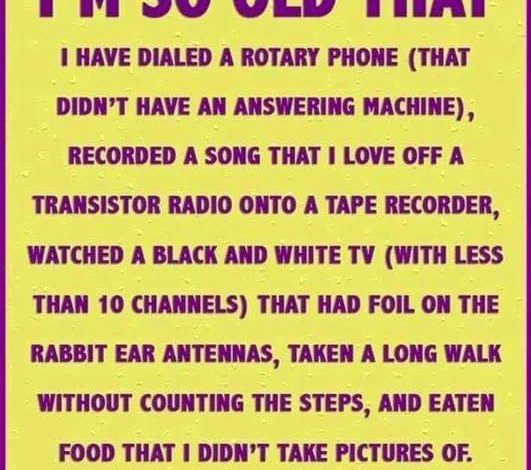
ADVERTISEMENT
“I’m So Old That…”: A Walk Down Memory Lane to the Analog Days
ADVERTISEMENT
Introduction
Nostalgia has a way of bringing people together, especially when it’s laced with memories of simpler technologies and practices that now seem almost unimaginable. The phrase “I’m so old that…” captures this sentiment perfectly, offering a humorous yet poignant look at everyday habits and tools that have since been replaced by digital alternatives. For those who lived through these experiences, it’s a reminder of the rapid pace of change, while for younger generations, it’s a glimpse into a world that feels like ancient history. Let’s dive into each of these “I’m so old that…” moments and rediscover the charm, quirks, and resilience of life in the analog age.
1. Dialing a Rotary Phone Without an Answering Machine
Before smartphones or even touch-tone phones, there was the rotary phone—a device with a circular dial that required patience and precision. To make a call, you’d place your finger in the numbered hole and rotate the dial clockwise. The distinctive clicking sound of the dial returning to its place became familiar in households around the world.
ADVERTISEMENT
And answering machines? They didn’t exist. If you missed a call, that was it—you simply didn’t know who had called unless they tried again later. The phrase “leave a message” was unheard of, and “call waiting” was still a distant dream. People arranged times to speak and stuck to their schedules, as there were no call logs or voicemail systems to fall back on. It was a time when phone communication was deliberate and thoughtful, unlike the instant, constant accessibility of today.
2. Recording a Song from the Radio onto a Tape Recorder
In the days before streaming platforms, recording a favorite song wasn’t as easy as pressing “download.” Many people would sit by their transistor radios, blank cassette at the ready, waiting for the DJ to play that perfect song. When it finally came on, there was a rush to hit the record button, hoping to capture it without the DJ talking over the intro or outro. This “tape culture” created a personal connection to music, with each recording marked by a sense of effort and anticipation.
These tapes weren’t just for personal enjoyment—they were shared with friends or turned into mixtapes, a personal and thoughtful way of sharing musical tastes. In many ways, this practice fostered a deeper appreciation for music, as listeners would listen intently, waiting for the moment to record, unlike today’s on-demand music access.
3. Watching Black and White TV with Foil on the Rabbit Ear Antennas
ADVERTISEMENT
Television viewing wasn’t always as clear or high-definition as it is today. Many households had black-and-white TVs with “rabbit ear” antennas that required constant adjustment. Aluminum foil became a makeshift booster, creating a unique and oddly effective solution for clearer reception. The number of channels was limited—often fewer than ten—and viewers sometimes had to physically adjust the antenna every time they switched the station.
Watching TV back then was a collective family experience, usually limited to specific shows at specific times. Without the luxury of streaming or even VCRs, people watched live broadcasts, commercials and all. If you missed an episode, you couldn’t just replay it—you had to wait for a rerun, which could take months. The ritual of watching TV was simple but memorable, filled with spontaneous DIY solutions like foil-wrapped antennas.
4. Taking Long Walks Without Counting Steps
Today’s world is filled with fitness trackers, step counters, and apps that quantify every move. But back in the day, people simply took walks for the pleasure of it or as a means of getting somewhere. There was no Fitbit, no “10,000 steps” goal to hit, and no app to track calories burned. Walking was a natural part of daily life, whether it was to the corner store, a friend’s house, or just for some fresh air.
Without metrics to measure each step, people were less focused on counting and more present in their surroundings. Long walks provided time to reflect, unwind, or bond with companions. Exercise was an inherent part of life rather than a monitored activity, and the simplicity of it all was refreshing compared to today’s data-driven fitness culture.
ADVERTISEMENT
5. Eating Food Without Taking Pictures of It
In today’s digital age, food photography is almost a ritual. Before taking the first bite, it’s common for people to snap a photo and share it on social media. However, there was a time when food was simply served, enjoyed, and appreciated without documentation.
Meals were often homemade, shared with family, and enjoyed for the taste and the company. The focus was on flavor and conversation rather than presentation and “likes.” Eating wasn’t a performance but an everyday activity that didn’t require validation or visual proof. The lack of digital distraction allowed people to be fully present, savoring each meal without a thought of how it would look on a screen.
6. The Analog Mindset: Living in the Moment
The common thread through all these experiences is an analog mindset—a way of life where people interacted with the world in real time, without the buffer of digital screens or instant connectivity. Life was slower, but it encouraged patience, creativity, and a certain resilience. Recording songs from the radio, adjusting TV antennas, and using rotary phones required more effort and attention, creating an attachment to each action that digital shortcuts often lack.
This analog approach taught people to work with what they had, embracing imperfections and improvisation. It wasn’t about instant gratification but about making do with what was available, finding joy in small victories, and valuing time and presence. Today’s constant connectivity and convenience offer incredible benefits, but they can sometimes rob us of the creativity and patience that defined the analog era.
7. Why These “Old” Experiences Are Meaningful Today
For those who remember, these experiences hold sentimental value, serving as reminders of a different time, one that feels almost surreal in today’s fast-paced world. For younger generations, these stories offer insight into a way of life that feels both alien and fascinating. Each of these “I’m so old that…” moments represents a tangible connection to the past, an era where life wasn’t necessarily easier, but it was simpler and perhaps more intentional.
Nostalgia for these moments goes beyond the objects themselves—it’s about remembering a time when life wasn’t dominated by screens and constant connectivity. These memories serve as a reminder that while technology offers ease and efficiency, there’s value in remembering and appreciating the hands-on, tactile experiences that shaped the lives of previous generations.
ADVERTISEMENT
Conclusion
The “I’m so old that…” reflection isn’t just about reminiscing; it’s a celebration of resilience, patience, and the beauty of simplicity. It reminds us that there was a time when connection meant waiting for a phone call, music was recorded by hand, and entertainment was communal and imperfect. While modern technology continues to change the way we live, these analog memories remain timeless, a testament to a generation that navigated life with creativity, patience, and an appreciation for the moment.
As we move forward, it’s worth taking a page from the past—remembering that sometimes, the beauty of life lies in the little imperfections, the uncounted steps, and the meals enjoyed without an audience. For those who lived through it, these memories are a badge of honor; for those who didn’t, they’re a glimpse into a world that was real, raw, and refreshingly unfiltered.




